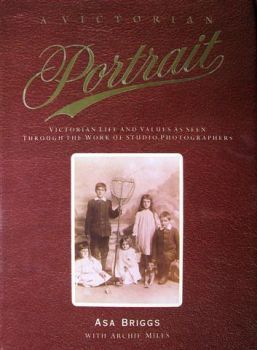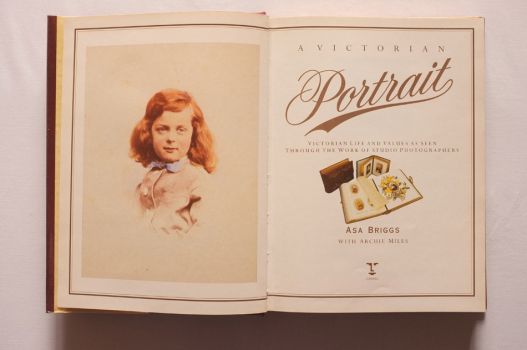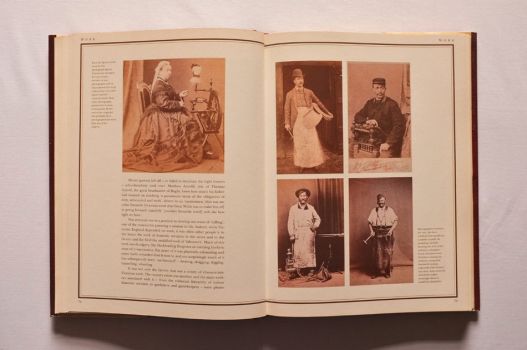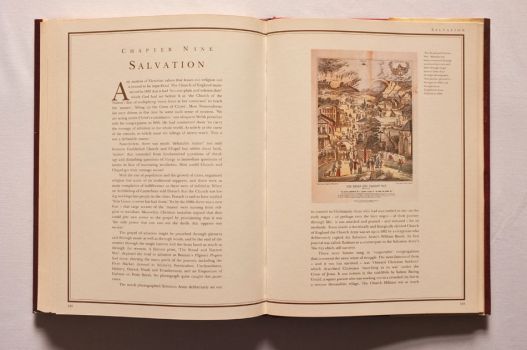“Wonderful vintage Victorian photos. Contains quite a wealth of commentary on the photos and the times in which they were taken.”
A Victorian Portrait
Victorian Life and Values as Seen through the Work of Studio Photographers
By Asa Briggs with Archie Miles
£25.00
A Victorian Portrait vividly depicts the social life of a nation from royalty down to the humblest artisan and labourer. It gives us a direct insight into the society of our great grandparents, allowing us to reassess the Victorians’ views on love, progress, self-help, work, leisure, empire, art, pride and salvation.
Dispatched next day with Royal Mail 2nd Class
- RRP: £25.00
- Format: 187 x 264 mm landscape
- Pages: 220
- Weight: 1.4 kg (3.1 lb)
- Pictures: 175 sepia & b/w, 75 colour
- Binding: Hardback with jacket
- ISBN: 978-0-304-31837-7
- Publication: 1989
Victorian Life and Values as Seen through the Work of Studio Photographers
The second half of the 19th century was a period of quite unprecedented change, an age of new technology and new ideas, during which the Victorians sought an identity and an image. Technology came up with the perfect answer: photography. Suddenly ordinary people had the opportunity to obtain a visual image of themselves, of family and friends, royalty and politicians, poets, actors and sportsmen at very low cost. The new hobby of collecting portraits soon became an obsession, spreading across North America, Europe and out to the trading posts of the Empire. This has left us with an exceptional legacy – one that has often been overlooked as an important historical source. For here we see the Victorians, both as they wished to be seen and as they really were. A Victorian Portrait draws on a previously unpublished archive of more than 10,000 portraits as well as a broad range of other visual material. New colour photography displays the beautifully decorated albums in which the Victorians collected their portraits, the card mounts edged and inscribed in gold and the photographic equipment of the studios.
CHAPTER 1: PORTRAIT AND PORTRAITS
CHAPTER 2: PROGRESS
CHAPTER 3: SELF-HELP
CHAPTER 4: WORK
CHAPTER 5: LEISURE
CHAPTER 6: LOVE
CHAPTER 7: PRIDE
CHAPTER 8: EMPIRE
CHAPTER 9: SALVATION
CHAPTE3R 10: INSPIRATION
CHRONOLOGY
COLLECTING VICTORIAN PHOTOGRAPHS
PICTURE CREDITS
INDEX
Asa Briggs was born at Keighley, Yorkshire, in 1921 and took his first degree in History and Economics. In the course of a distinguished career, he has been Professor of Modern History at Leeds University (1955-61) and Professor of History at the University of Sussex, where he was Vice-Chancellor from 1967 to 1976.
His main field of interest is the social and cultural history of the 19th and 20th centuries, on which he has written many books, including The Age of Improvement, Victorian People, Victorian Cities, Victorian Things, A Social History of England and a four-volume history of broadcasting.
Lord Briggs was made a life peer in 1976 and became Provost of Worcester College, Oxford, later that same year. At the age of 92 he published his final book, Loose Ends and Extras, in which he reflects on our relationship with time. Lord Briggs died in March 2016 at the age of 94. He is survived by his wife Susan Banwell and their four children.
Archie Miles, also a Yorkshireman, is a professional photographer specializing in landscape, commercial and industrial photography. In 1975 he was given a complete album of carte-de-visite portraits which sparked off his interest in the genre and the way in which photography gripped the imagination of the Victorians. He has been an avid collector and enthusiast ever since, and now has a major collection of over 10,000 carte-de-visite and cabinet photographs.
His interest in the subject has led him to pursue much detailed original research into the techniques of Victorian portrait photography and into the lives of the photographers and their subjects. In this book he has supplied most of the original photographs, album illustrations and ephemera as well as caption notes and research materials from his collection.
PORTRAIT AND PORTRAITS
The most brilliant of all essays on Victorian England is called Portrait of an Age. Its author, G. M. Young, writing during the early 1930s and trying to explain what the Victorians were really like, had a strong visual sense. ‘Every one of us’, he claimed, ‘lives in a landscape of his own.’
Young described how things changed – or did not change – in the years between Queen Victoria’s coronation in 1837 and her funeral in 1901, catching the light and the shade. Yet he had nothing to say about photography, the great nineteenth-century invention which changed ways both of viewing and of recording the world. Photography was a triumph of science, but could be conceived of and practised both as an art and as a trade.
EMPIRE
As photography developed there was an increasing interest, expressed also in museums of anthropology, in ‘native ways’. In cartes-de-visite and stereographs the ‘natives’ themselves were sometimes treated as exotic specimens, not least when they were produced, as some were, not in London but in Auckland, Melbourne or Durban. There were many ‘natives’, however, particularly American Indians, who clearly appealed sympathetically to their photographers. There was a strong sense, too, among some photographers that they were recording dress and ways of life that were under threat and that would soon disappear. In Britain anthropologists like the director of the Pitt Rivers Museum, which moved to Oxford in 1883, regarded photographs as so important an adjunct to a museum, that he tried ‘to buy all I can’. Only photographs now remain of the aboriginal inhabitants of Tasmania.











